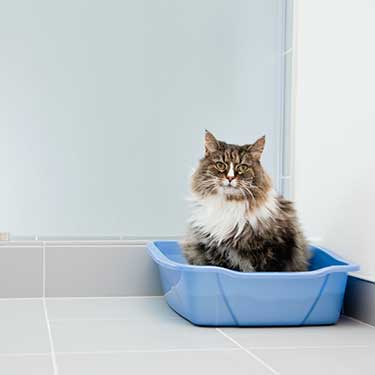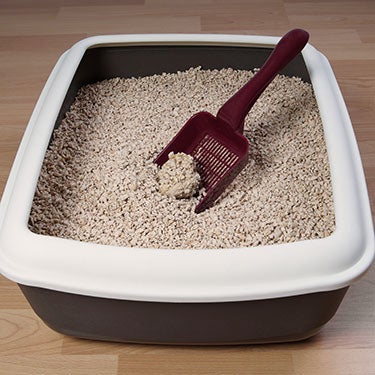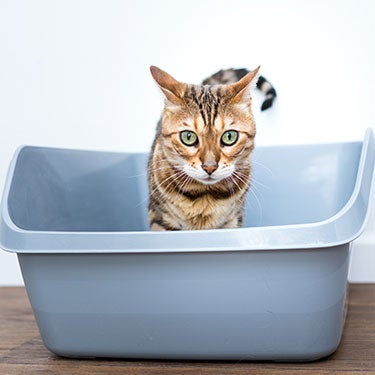Thinking Inside the Box
Your litter box training guide.It’s an exciting day. You’ve adopted a new feline family member. On behalf of cat lovers everywhere, we thank you for opening your heart and home to a cat.
There are the purring, playing and cuddles to look forward to. But there’s also the logistics. How do you train a new cat to find and use the litter box? Luckily, you’ve come to the right place. We’re the kitty litter experts.
Whether you want to know how to help a kitten learn how to use a litter box, or find out why your adult feline is avoiding the box, we’ve got all the tips you need to successfully litter train your cat.
Litter training a kitten.

One of the (many) great things about kittens is that they may start to instinctively want to use a litter box as soon as they’re about 3–4 weeks old.1 But that tiny fuzzball is still learning, and might need a little encouragement. Here are some tips to ensure a first timer’s success:
- A Room of Kitty’s Own: For the first week (especially if the kitten is very young), contain the kitten in a room with her litter box and food, but keep the food as far away from the litter as possible. This lets Kitten acclimate to her new home and gets her used to litter.
- Don’t Clump Me In: Many vets recommend non-clumping litter for kittens. After two or three months you can gradually transition them to clumping litter.
- I Have Tiny Legs!: Use a shallow, small litter box so Kitten doesn’t have trouble getting into it.
- Shhh, I Must Concentrate: Put the litter in a quiet, private space so Kitten doesn’t get distracted.
- Learning About Litter: Keep placing
Kitten in the litter box to get her used to her new box, especially after a nap or eating. - Give Me a Helping Paw: If Kitten is a little confused, you can help her by putting your hand on her paw and gently encouraging her to scratch. Usually, she’ll take this up on her own, and instinctively know that this is her toilet. If she does, give her a treat!
- Oops, I Missed: If she goes outside the box, don’t get mad at her or yell or force her into the box. She might get scared (wouldn’t you?) and start associating the litter box with punishment.
With the right training and a little natural instinct, Kitten will soon be a litter box champ.
How to litter train an adult cat.

An adult cat (unless they’re feral), will generally know how to use a litter box already. That’s because cats are SMART and BEAUTIFUL. However, there are a couple of tips to make sure Kitty knows where her litter box is and how to use it correctly.
- Privacy,
Please: Cats like their privacy as much as humans. Put the box in a quiet, accessible location that’s easy to clean, such as a bathroom.4 Got a multi-level house? We recommend having a litter box per level. - Dude, Where’s My Box?: Place the cat in the box several times so she knows where it is. If you need to move it, move it gradually over several days so Kitty doesn’t get confused.
- Just My Size: Make sure the litter box is a comfortable size for your cat. It should be one and a half times her body length. Cats generally prefer an open box.4
- A Box for Every Cat: Got more than one cat? Make sure you have enough litter boxes for everyone. The rule of thumb is one box per cat, plus one. So if you have two cats, get three litter boxes.
- I Love a Fresh, Clean Litterbox: Cats are very sensitive to odors, and they might reject a litter box that’s too messy.4 So scoop out solids once a day, and follow the directions on your favorite kind of Fresh Step® litter to keep the box smelling clean and fresh.
Soon Kitty will be using her litter box regularly and it will be one of her happy places. But sometimes…
Accidents happen.

Occasionally — or maybe often — your cat might miss the litter box or stop using it entirely. Let’s troubleshoot this thing.Is the box clean? Cats, like people, enjoy a clean bathroom.4 If Kitty is avoiding the box, she might be giving you a hint that it’s time to clean it out. Give Kitty what she needs, a box filled with clean Fresh Step® litter.
Is your cat sick? Cats won’t tell you that they’re sick. Sometimes the litter box is the first clue. If Kitty is avoiding the litter box, going a lot or just can’t make it in time, it’s time to take her to the vet.4 She needs a doctor’s help.
Do you have enough boxes? Each cat in your household should have his/her own box.5 So, getting an extra litter box might be just the trick.
After checking off those boxes (see what we did there?), and Kitty is still relieving herself in inappropriate places, try these tricks:
- Clean the area with an enzyme cleaner to remove any odor marks for the cat.6 If she went there once, and she smells her own pee there, she’ll be tempted to go there again.
- After cleaning the area with an enzyme cleaner, put a couple of treats down: Cats, like humans, don’t like to “go” where they eat.
- Block the area off.
- Or cover it generously with a plastic cover liner, teeth side up, plastic wrap or tin foil. After a few weeks, you should see success.
- Try unscented litter. Some cats have extra-sensitive noses.
Good luck! Remember, the number one reason cats avoid the litter box is because the litter isn’t clean. So, make sure your kitty always has a supply of clean, effective Fresh Step® litter.
Get lots of litter with the Paw Points® program.
Join the Fresh Step® Paw Points® program, and you’ll earn points every time you buy litter. It’s easy to rack up the points — and then you can redeem for fresh, free litter (along with toys, entries into our big sweepstakes and even donations for your favorite cat shelter).
1. How old is that kitten? Kitten guide: Three weeks. (n.d.) https://www.alleycat.org/resources/how-old-is-that-kitten-guide-three-weeks/
2. Litter training. (n.d.). http://www.kittenlady.org/litter
3. Preventing litter box problems. (n.d.). https://www.humanesociety.org/resources/preventing-litter-box-problems
4. Litter box problems. (n.d.). https://www.aspca.org/pet-care/cat-care/common-cat-behavior-issues/litter-box-problems
5. What multiple cats need multiple litter boxes. (n.d.). https://www.petmd.com/cat/centers/litter/evr_why_multi_cat_households_need_multiple_litter_boxes
6. McCarthy C. (n.d.). How to clean cat urine. https://www.petmd.com/cat/care/how-clean-cat-urine




